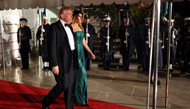▶ When Middle East Conflicts Become One
▶ DAVID BROOKS
But it is not 1979. People’s mental categories may be stuck in the past, but reality has moved on. The violence between Israel and Hamas, which controls Gaza, may look superficially like past campaigns, but the surrounding context is transformed.
What’s happened, of course, is that the Middle East has begun what Richard Haass of the Council on Foreign Relations has called its 30 Years’ War — an overlapping series of clashes and proxy wars that could go on for decades and transform identities, maps and the political contours of the region.
The Sunni-Shiite rivalry is at full boil. Torn by sectarian violence, the nation of Iraq no longer exists in its old form.
The rivalry between Arab authoritarians and Islamists is at full boil. More than 170,000 Syrians have been killed in a horrific civil war, including 700 in two days alone, the weekend before last, while the world was watching Gaza.
The Sunni vs. Sunni rivalry is boiling, too. Saudi Arabia, Qatar, Turkey and other nations are in the midst of an intra-Sunni cold war, sending out surrogates that distort every other tension in the region.
The Saudi-Iranian rivalry is going strong, too, as those two powers maneuver for regional hegemony and contemplate a nuclear arms race.
In 1979, the Israeli-Palestinian situation was fluid, but the surrounding Arab world was relatively stagnant. Now the surrounding region is a cauldron of convulsive change, while the Israeli-Palestinian conflict is a repetitive Groundhog Day.
Here’s the result: The big regional convulsions are driving events, including the conflict in Gaza. The Israeli-Palestinian conflict has become just a stage on which the regional clashes in the Arab world are being expressed. When Middle Eastern powers clash, they take shots at Israel to gain advantage over each other.
Look at how the current fighting in Gaza got stoked. Authoritarians and Islamists have been waging a fight for control of Egypt. After the Arab Spring, the Islamists briefly gained the upper hand. But when the Muslim Brotherhood government fell, the military leaders cracked down. They sentenced hundreds of the Brotherhood’s leadership class to death. They also closed roughly 95 percent of the tunnels that connected Egypt to Gaza, where the Brotherhood’s offshoot, Hamas, had gained power.
As intended, the Egyptian move was economically devastating to Hamas. Hamas derived 40 percent of its tax revenue from tariffs on goods that flowed through those tunnels. One economist estimated the economic losses at $460 million a year, nearly a fifth of the Gazan G.D.P.
Hamas needed to end that blockade, but it couldn’t strike Egypt, so it struck Israel. If Hamas could emerge as the heroic fighter in a death match against the Jewish state, if Arab TV screens were filled with dead Palestinian civilians, then public outrage would force Egypt to lift the blockade. Civilian casualties were part of the point. When Mousa Abu Marzouk, the deputy chief of the Hamas political bureau, dismissed a plea for a cease-fire, he asked a rhetorical question, “What are 200 martyrs compared with lifting the siege?”
The eminent Israeli journalist Avi Issacharoff summarized the strategy in The Times of Israel, “Make no mistake, Hamas remains committed to the destruction of Israel. But Hamas is firing rockets at Tel Aviv and sending terrorists through tunnels into southern Israel while aiming, in essence, at Cairo.”
This whole conflict has the feel of a proxy war. Turkey and Qatar are backing Hamas in the hopes of getting the upper hand in their regional rivalry with Egypt and Saudi Arabia. The Egyptians and even the Saudis are surreptitiously backing or rooting for the Israelis, in hopes that the Israeli force will weaken Hamas.
It no longer makes sense to look at the Israeli-Palestinian contest as an independent struggle. It, like every conflict in the region, has to be seen as a piece of the larger 30 Years’ War. It would be nice if Israel could withdraw from Gaza and the West Bank and wall itself off from this war, but that’s not possible. No outsider can run or understand this complex historical process, but Israel, like the U.S., will be called upon to at least weaken some of the more radical players, like the Islamic State in Iraq and Syria and Hamas.
In 1979, the Arab-Israeli dispute looked like a clash between civilizations, between a Western democracy and Middle Eastern autocracy. Now the Arab-Israeli dispute looks like a piece of a clash within Arab civilization, over its future.
스마터리빙
more [ 건강]
[ 건강]이제 혈관 건강도 챙기자!
[현대해운]우리 눈에 보이지 않기 때문에 혈관 건강을 챙기는 것은 결코 쉽지 않은데요. 여러분은 혈관 건강을 유지하기 위해 어떤 노력을 하시나요?
 [ 건강]
[ 건강]내 몸이 건강해지는 과일궁합
 [ 라이프]
[ 라이프]벌레야 물럿거라! 천연 해충제 만들기
 [ 건강]
[ 건강]혈압 낮추는데 좋은 식품
[현대해운]혈관 건강은 주로 노화가 진행되면서 지켜야 할 문제라고 인식되어 왔습니다. 최근 생활 패턴과 식생활의 변화로 혈관의 노화 진행이 빨라지고
사람·사람들
more많이 본 기사
- 트럼프, 엡스타인 파일 공개법 서명… “민주당에 역풍 불것”
- 美, ‘中의존 탈피’ 위해 사우디와 희토류 공급망 추진
- 새 종전안으로 우크라이나 압박하는 트럼프…전선에선 공방 격화
- “트럼프, ‘AI규제 州법 무력화’ 추진…소송·예산지원 중단”
- 아이폰 있으면 국내선 여권 불필요 1
- 李대통령 “북핵 고도화 방치안돼…실용적·단계적 한반도비핵화”
- 무인도 좌초 여객선 항해사, 휴대전화 딴짓하다가 ‘쾅’
- 샬럿 대대적 불체자 단속에 한인사회 긴장
- “의회, 펠로시 주식 논란에 ‘국회 주식거래 금지법’ 본격 논의”
- 美, 중동에 엔비디아 최신칩 수출 승인…對韓수출 불확실성↓
- 엔비디아 또 ‘사상최고’ 실적… ‘AI거품’ 논란 일축하고 주가↑
- 메디케이드·식량·주거 보조 이용… 영… 3
- 트럼프, 조지아 단속에 “난 바보같이… 1
- “美, 韓에 ‘디지털 규제 추진하면 무역법 301조 조사한다’ 경고”
- 현빈♥손예진, 최초 부부 동반 남녀주연상..트로피 4개 집으로 [청룡영화상]
- “무너진 캘리포니아 재건하겠다” 3
- “섬김과 연합으로 선한 영향력 전하는 총연 이끌 것”
- 나경원 등 ‘패스트트랙 충돌’ 오늘 1심 선고…발생 6년7개월만
- 오프라인 한국어 과정 성공적 마무리 단계
- 다솜한국학교, 새미 리 박사 통해 정체성 교육 강화
- 브룩필드, 1천억 달러 규모 AI인프라 프로그램 조성…엔비디아 참여
- 빈살만 극진환대 트럼프…영부인 만찬 … 1
- 李대통령 이집트 도착…對중동 정책 ‘카이로 구상’ 천명 주목
- “소득대비 과도 공제… IRS 감사타겟 될 수도”
- 맥도널드, 연말 인기메뉴 ‘맥립’ 출시
- 이젠 프리웨이도 달리는 웨이모
- 현대차그룹 차량들, 충돌평가 ‘최고 등급’
- 유병홍씨 자전소설 ‘불사조’ 출간
- “미·러 새 종전안, 우크라 영토양보… 1
- 호날두 직접 만난 美 대통령 “아들 앞에서 체면 살아” 농담... 일론 머스크·빈 살만과 함께 ‘백악관 만찬’
- 실적낸 여성 뉴욕경찰수장, ‘진보’ … 1
- [미국은 지금] 미국 정치의 파산과 그 댓가
- 계속되는 민주당의 헛손질
- “동양인 비하 제스처, 인종차별 맞다… 1
- ‘엡스타인파일 공개 법안’ 의회 문턱넘어…트럼프 서명만 남아
- 의회가 공개 결정한 ‘엡스타인 파일’… 정·재계 새 뇌관 되나
- 韓 사상 첫 ‘월드컵 포트2’ 확정, 문제는 ‘포트2답지 못한’ 홍명보호 경기력
- 젠슨황과 돈독해진 트럼프, 엔비디아 AI칩을 외교 카드로 활용
- 한인 대형교회 전도사 113만불 횡령… 1
- 尹 내란 재판에 홍장원 다시 출석…진술 신빙성 공방 전망
- ‘엡스타인 파일 연루’ 서머스 전 재무, 오픈AI 이사직 사임
- 마라나타 비전교회, 장로/안수집사 임직및 장로 은퇴예배
- ‘호객 없는 수산시장’… 제철 맞은 방어, 새우 먹으러 울진 간다
- 유엔위원회, 北인권결의안 만장일치 채택…한미일 등 공동제안
- 사라진 백악관의 이스트 윙
- 북VA 불법 마사지업소 260곳 넘는다
- AI 확산에 올해 일자리 110만개 사라져
- 뉴욕증시, 엔비디아 실적 앞두고 변동성…동반 강세 마감
- 푸드스탬프 수혜자 재신청 절차 요구할 것
- 손흥민, ‘임신 협박 3억 갈취’ 20대女 재판에 ‘증인 출석’... 50분간 비공개 신문
1/5지식톡

-
 테슬라 자동차 시트커버 장착
0
테슬라 자동차 시트커버 장착
0테슬라 시트커버, 사놓고 아직 못 씌우셨죠?장착이 생각보다 쉽지 않습니다.20년 경력 전문가에게 맡기세요 — 깔끔하고 딱 맞게 장착해드립니다!장착비용:앞좌석: $40뒷좌석: $60앞·뒷좌석 …
-
 식당용 부탄가스
0
식당용 부탄가스
0식당용 부탄가스 홀세일 합니다 로스앤젤레스 다운타운 픽업 가능 안녕 하세요?강아지 & 고양이 모든 애완동물 / 반려동물 식품 & 모든 애완동물/반려동물 관련 제품들 전문적으로 홀세일/취급하는 회사 입니다 100% …
-
 ACSL 국제 컴퓨터 과학 대회, …
0
ACSL 국제 컴퓨터 과학 대회, …
0웹사이트 : www.eduspot.co.kr 카카오톡 상담하기 : https://pf.kakao.com/_BEQWxb블로그 : https://blog.naver.com/eduspotmain안녕하세요, 에듀스팟입니다…
-
 바디프렌드 안마의자 창고 리퍼브 세…
0
바디프렌드 안마의자 창고 리퍼브 세…
0거의 새제품급 리퍼브 안마의자 대방출 한다고 합니다!8월 23일(토)…24일(일) 단 이틀!특가 판매가Famille: $500 ~ $1,000Falcon: $1,500 ~ $2,500픽업 & 배송직접 픽업 가능LA…
-
 바디프렌드 안마의자 창고 리퍼브 세…
0
바디프렌드 안마의자 창고 리퍼브 세…
0거의 새제품급 리퍼브 안마의자 대방출 한다고 합니다!8월 23일(토)…24일(일) 단 이틀!특가 판매가Famille: $500 ~ $1,000Falcon: $1,500 ~ $2,500픽업 & 배송직접 픽업 가능LA…
케이타운 1번가
오피니언
 정숙희 논설위원
정숙희 논설위원사라진 백악관의 이스트 윙
 파리드 자카리아 워싱턴포스트 칼럼니스트 / CNN ‘GPS’ 호스트
파리드 자카리아 워싱턴포스트 칼럼니스트 / CNN ‘GPS’ 호스트 계속되는 민주당의 헛손질
 김동찬 시민참여센터 대표
김동찬 시민참여센터 대표 [미국은 지금] 미국 정치의 파산과 그 댓가
 성영라 수필가 미주문협 부이사장
성영라 수필가 미주문협 부이사장 [수요 에세이] 부석사, 배흘림기둥에 기대어 보다
 서정명 / 서울경제 논설위원
서정명 / 서울경제 논설위원[만화경] ‘국부론’과 “기업이 곧 국력”
 노세희 부국장대우·사회부장
노세희 부국장대우·사회부장 대한은 다시 살아나는가
 민경훈 논설위원
민경훈 논설위원사자와 생쥐, 그리고 인간 이야기
 한형석 사회부 부장대우
한형석 사회부 부장대우 한인타운 교통 인프라 개선 기대
 박영실 시인·수필가
박영실 시인·수필가 [화요칼럼] 말의 위력
1/3지사별 뉴스

22기 뉴욕평통 출범식⋯“힘찬 출발”
22기 민주평화통일자문회의 뉴욕협의회(회장 이시화)는 17일 퀸즈 플러싱 소재 코리아빌리지 디모스 연회장에서 자문위원 173명을 비롯한 한인사…
메디케이드 받으면 영주권 신청 거부된다

VA 주지사 인수인계 ‘삐걱’…UVA 총장 선임 ‘격돌’
버지니아 글렌 영킨(Glenn Youngkin, 공화, 사진 왼쪽) 주지사와 내년 1월 취임하는 아비가일 스팬버거(Abigail Spanber…
북VA 불법 마사지업소 260곳 넘는다

오프라인 한국어 과정 성공적 마무리 단계
샌프란시스코 한국 교육원(허혜정 원장)이 2025년 가을 학기에 처음 개설한 오프라인 한국어 과정 ‘한국어 1’이 오는 22일 성공적인 마무리…
마라나타 비전교회, 장로/안수집사 임직및 장로 은퇴예배

오늘 하루 이 창 열지 않음 닫기 





















































.png)


댓글 안에 당신의 성숙함도 담아 주세요.
'오늘의 한마디'는 기사에 대하여 자신의 생각을 말하고 남의 생각을 들으며 서로 다양한 의견을 나누는 공간입니다. 그러나 간혹 불건전한 내용을 올리시는 분들이 계셔서 건전한 인터넷문화 정착을 위해 아래와 같은 운영원칙을 적용합니다.
자체 모니터링을 통해 아래에 해당하는 내용이 포함된 댓글이 발견되면 예고없이 삭제 조치를 하겠습니다.
불건전한 댓글을 올리거나, 이름에 비속어 및 상대방의 불쾌감을 주는 단어를 사용, 유명인 또는 특정 일반인을 사칭하는 경우 이용에 대한 차단 제재를 받을 수 있습니다. 차단될 경우, 일주일간 댓글을 달수 없게 됩니다.
명예훼손, 개인정보 유출, 욕설 등 법률에 위반되는 댓글은 관계 법령에 의거 민형사상 처벌을 받을 수 있으니 이용에 주의를 부탁드립니다.
Close
x